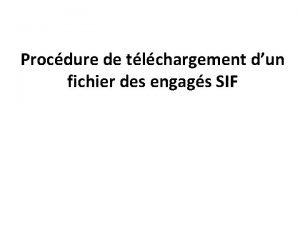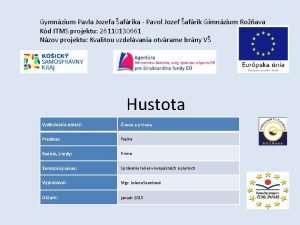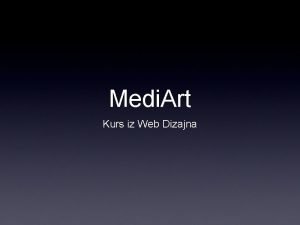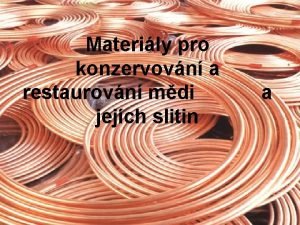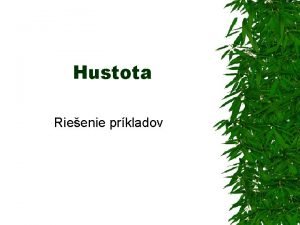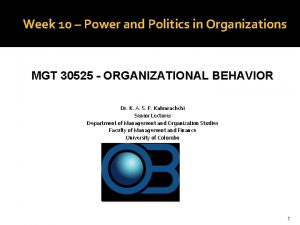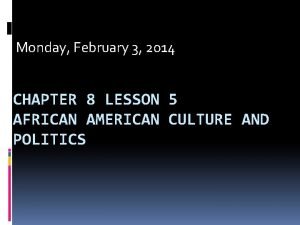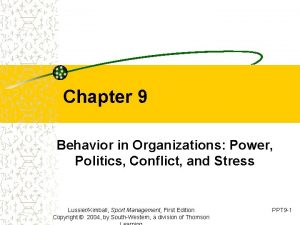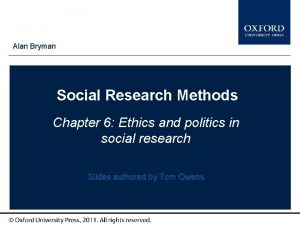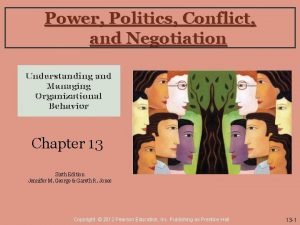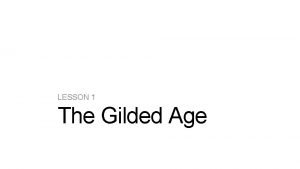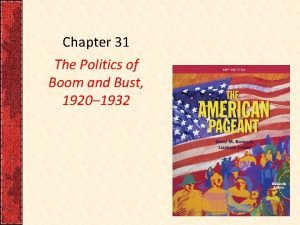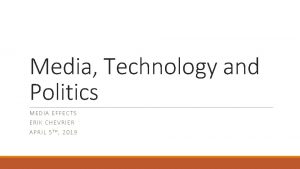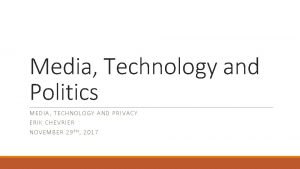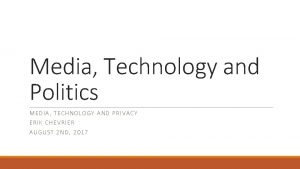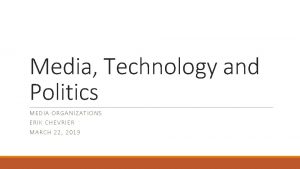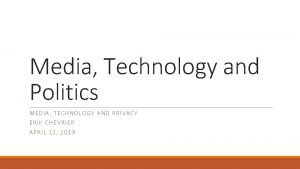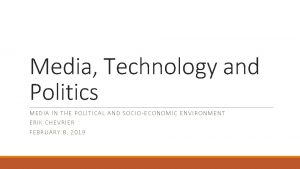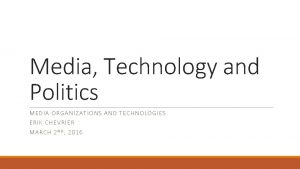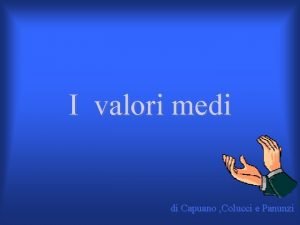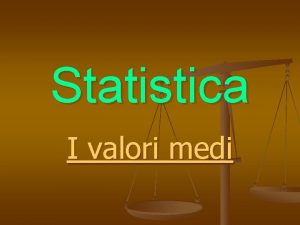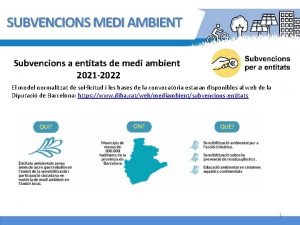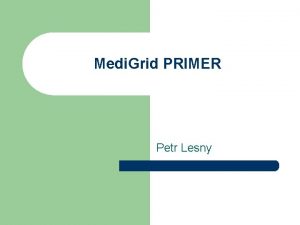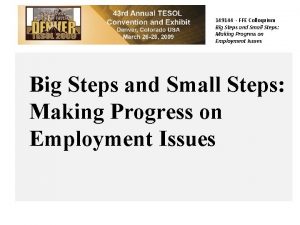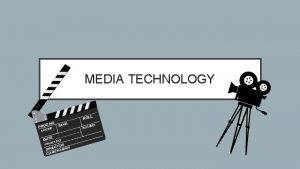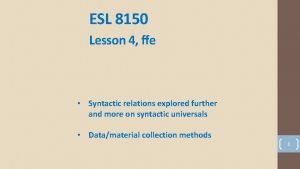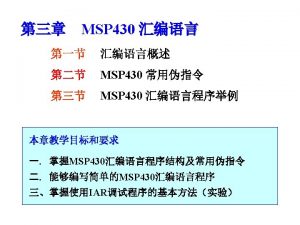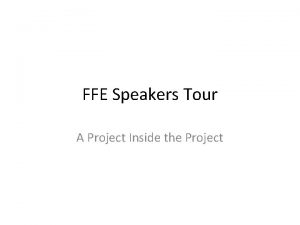Media Technology and Politics MEDI A E FFE























- Slides: 23

Media, Technology and Politics MEDI A E FFE CTS ERIK C HEVRIER JULY 31, 2017

Media Effects Media effects research usually describes the reception/reading of codes/forms/texts Receivers are also affected by (and have an effect on) ◦ Media organizations and technology ◦ Political and socio-economic environment Media Organizations and technologies are affected by (and have an effect on) ◦ Political and socio-economic environment ◦ Receivers (audiences) Mc. Luhan – The Medium is the message Machines are an extension of our human experience and bodily sensations

How are you Affected by Media General Examples Very basic examples of how I can affect your emotional state via video ◦ Example 1 ◦ Example 2 ◦ Example 3 Small variations in media texts produce different interpretations ◦ Example People are fallible ◦ Example What do people learn from media? ◦ Example

Looking at Nesbitt-Larking Moral panic Magic bullet/hypodermic ◦ ◦ War of the Worlds War of Worlds follow up Manufacturing Consent Colin Powell Speech about Weapons of Mass Destruction ◦ Leni Riefenstahl’s Triumph of Will – Nazi Propaganda Video ◦ Donald Trump Pledge ◦ Richard Spenser – Hail Trump Video Limited effects/uses and gratifications ◦ Two-step communication flow/discursive elaboration ◦ Selective attention/cognitive beliefs/selective recall Critical perspective ◦ Freedom within determining conditions ◦ Personality ◦ Polysemic ◦ Gendered reading formations ◦ Ontological Engagement with Media

Media Fantasy Becomes Reality Jean Baudrillard ◦ The media – especially when the content is fictional and fantastic – are more real than the world they proport to represent. ◦ The symbolic structure of the media is so powerful that the meaning is dissolved as mere content is relegated to the demands of form. ◦ Verisimilitude - They appear to be real. Mark Poster ◦ Mediation is becoming so intense and worked over that ‘reality’ is consistently in question Nesbitt-Larking ◦ Forms that blend reality: ◦ ◦ ◦ Infotainment Docudrama ‘Faction’ – blending fact from fiction Reality television News/entertainment spoof

How to Propagate Effectively The next section is an overview of leading theories regarding factors that help influence people. If you will be involved in political campaigning or devising media strategy, you should utilize some of the following methods. The power of words in regards to memory

Priming/Framing/Schema COGNITIVE MODEL SEMANTIC PROCESSING – SPREADING ACTIVATION

The Power of Suggestion An Inquiry Into How People Are Affected by Profuse Amounts of Publicity: A Multidisciplinary Approach Advertising as a suggestion – Page 26 Suggestions can bypass critical thought because there is no direct request to refuse

The Psychology of Influence Robert Cialdini Six weapons of influence 1 – Reciprocation 2 – Commitment and consistency 3 – Social proof 4 – Liking 5 – Authority 6 – Scarcity

Learning Theories Social modeling Classical conditioning Operant conditioning Internal vs external motivation

Changing Values and Attitudes Values: Cognitive dissonance: Desirable, trans-situational goals, varying in importance, that serve as a guiding principles in people’s lives Cognitive dissonance is a state of psychological tension occurring when thoughts, beliefs, attitudes, and/or behaviours are in conflict with each other. Attitudes: An internal state that, given the occurrence of certain stimulus events, will ultimately result in some sort of response or behaviour. Key Factors: Ratio of dissonance Importance of factors in dissonance Avoiding dissonance 1 – Modify 2 – Change importance 3 – Rationalize 4 – Add new consonant beliefs to bolster

Compliance Techniques Foot in the door: An individual who agrees to carry out a small request is subsequently more likely to agree to carry out a larger request Door in the face/reciprocal concessions: When the person making the larger request reduces it to a smaller one, the other person feels obliged to make a matching concession Low-ball/bait and switch: When an agreement is made, the offer reduces in value Improving the deal: When a product is offered at a high price, then after a brief pause, another product is offered to the deal or the price is reduced Guilt: People comply to reduce feelings of guilt

Factors that Help Influence Groupthink ◦ In group vs out group ◦ Conformity to group ◦ Social Roles – Stanford prison experiment Physical Factors ◦ ◦ Appearance/attractiveness Likability Similarities Non-verbal communication Emotional Appeal ◦ ◦ Fear Sadness Embarrassment Confidence Savvy Media Consumer Appeal: ◦ Honest about media influence Contagion: ◦ When large crowds form, people may behave in ways that is extreme and unlike their normal behaviour

Me-Media Problems with studying media effects ◦ Media changes rapidly and suddenly ◦ Scholars are continuously trying to keep up with the rapidly changing media landscape ◦ Turns scholars into ‘storm chasers’

Media Effects – Me-Media Democracy vs illusion of involvement Democracy ◦ Todd Gitlin (1999) – “Because of technology, relentless horizontal momentum is irreversible. The vertical cannot hold…Roll over authorities – the culture of the next millennium is not going your way. ” ◦ Francis Fukuyama – “hierarchies of all sorts, political and corporate, have come under pressure and begun to crumble” ◦ Esther Dyson – “the great virtue of the Internet is that it erodes power. It sucks power out of the center and takes it to the periphery: it erodes the power of institutions over people while giving to the individuals the power to run their own lives”. ◦ Manuel Castells – “ ‘network’ society had become so expansive, powerful, global, and instant that it had the capacity to overwhelm and sideline the nation state” ◦ Manuel Castells – Later admits that media conglomerates dominate many areas of these networks and nation states have a stubborn staying power, levers of control over the organization of daily life, and an emotional bond with their citizens that make them difficult to circumvent. ◦ Cognitive surplus

Media Effects - Me-Media Democracy vs illusion of involvement Illusion of involvement Malcolm Gladwell – Social media “are effective at increasing participation – but lessening the level of motivation that participation requires”. “Little can be achieved without strong leaders, hard core political action and specific policy solutions”. Manuel Castells – It is the looseness and diversity of these movements that allow these movements to create their own cyber-environment, a signature of their success. Clay Shirky – The very virtues that can make online political engagement so effective – such as the ability to reach millions and stretch across the globe – can also be impediments to action. Christopher Waddell on the 2011 Canadian Election – Social media did NOT figure predominantly into the Canadian election campaign or it’s outcome because: Limited number of people on social media, narrow range of issues highlighted, lack of impact on issues, not many uses for social media. 2012 USA presidential elections had 9% less voter turnout than the previous election VOTE TOGETHER CAMPAIGN

Media Effects - Me-Media Efficiency vs inefficiency Efficiency ◦ Digital natives learn to multi-task, orient to networks and monitor their environments in ways that the pre-digital world is unable to match Inefficiency ◦ ◦ People are less able to think deeply about a problem We are being rewired into shallow thinkers We do not fully engage with the communities we get involved with online Digital ADD

Media Effects - Me-Media Identity ◦ ◦ ◦ ◦ ◦ Identity ghettos Self-confirming bias (confirmation bias) Selective exposure Search bias (algorithm based on previous searches) Echo chamber Greater number of choices leads to political polarization Self-performance and management of impressions Social capital ‘online friends’ Feelings of missing out Sunstein – narrowing information happens in two ways: ◦ Loss of by-product learning ◦ Information ghettos expose people to limited information pool Markus Proir – People who are interested in politics tend to migrate from news program to news program regardless whether they are liberal or conservative.

Media Effects - Me-Media Absence in presence – attention is elsewhere Presence in absence – you can be there even if you are not physically present (telepresence) ◦ Erosion of time and space Inequalities persist – Access problem, subscriptions, etc. Dangers – Privacy, data, cyber-bullying, extreme content

Media Effects – Cable Explosion Narrowcasting and fragmentation Subscriptions (advertising and subscription costs) Audience niche Cable revolution weakened structures of Canadian television: ◦ ◦ ◦ Syphoning away money from advertisers Competition, reluctance to invest in high-quality productions Altered boundaries towards more sensational programming Offloading of politics to the back alleys of TV Canadian content cannot compete

Media Effects – Blogs Journalism vs blogging ◦ ◦ ◦ Blogging not seen as a credible form of journalism Bloggers may be able to respond to a story more quickly Some journalists get information from blogs to begin a story Blogging may provide missing perspectives not covered by mainstream media Blogging is like journalism without a salary and organization to back you up with legal troubles Four categories of blogs ◦ ◦ Cyber-Celebrities Aggregator - centralizes a number of news and blog sites Celebrities themselves Ordinary people

Media Effects - You. Tube Largest online video archive Greatest teaching tools Attracting more and more advertising National television are a large part of You. Tube content News moments Amateur production Mobilizing citizens – contagion effect ◦ Double edge sword – spying on activists

Questions? Please read this chapter carefully and understand the divergence of opinions in regards to the ‘effects of the Internet’ If you have any questions or concerns, please make an appointment with me.
 Ffe bo engagement
Ffe bo engagement Economic challenges in media and information
Economic challenges in media and information Hustota hlinika kg/m
Hustota hlinika kg/m Aká je hustota plastelíny
Aká je hustota plastelíny Medi derma s spray
Medi derma s spray Is people as media
Is people as media Medi art
Medi art Mediassistindia login
Mediassistindia login Patinování mědi
Patinování mědi Meditouch israel
Meditouch israel Medi smart
Medi smart Hustota hlinika kg/m
Hustota hlinika kg/m Power and politics in organizations
Power and politics in organizations Lesson 5 african american culture and politics
Lesson 5 african american culture and politics Bureaucracy and politics in india
Bureaucracy and politics in india Power politics and conflict in organizations
Power politics and conflict in organizations Ethics and politics in social research bryman
Ethics and politics in social research bryman Conflict power and politics
Conflict power and politics Philosophy, politics and economics michael munger
Philosophy, politics and economics michael munger The tournament of today
The tournament of today Chapter 31 the politics of boom and bust
Chapter 31 the politics of boom and bust Whose government politics populists and progressives
Whose government politics populists and progressives Polis bsc
Polis bsc Government unit 1 study guide
Government unit 1 study guide
